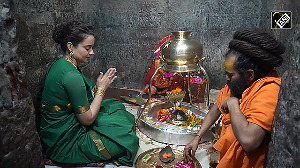 Air quality in the national capital deteriorated alarmingly a day after Diwali as pollution levels spiked more than five times higher than normal leaving many at the risk of respiratory problems.
Air quality in the national capital deteriorated alarmingly a day after Diwali as pollution levels spiked more than five times higher than normal leaving many at the risk of respiratory problems.
The Respirable Suspended Particulate Matter, which directly affects breathing, has gone up by five times from the national ambiance air quality standard, stated scientists from System of Air quality and Weather Forecasting and Research. "The 24-hours average of PM10 was recorded at 427 mg per cubic metre and PM2.5 was at 278 mpcm, almost five times higher than the prescribed standard of 100 mpcm and 60 mpcm respectively," said senior scientist Dr Gufran Beig at SAFAR, which is jointly run by the Indian Institute of Tropical Meteorology and India Meteorological Department.
"These pollutants can harm the heart and brain as well. People with existing heart or lung diseases such as asthma, chronic obstructive pulmonary disease, congestive heart disease, or ischemic heart disease are at increased risk of admission to hospitals based on the severity of already existing problem," he said.
Since 10 pm onwards, an upward trend was witnessed at all six air quality monitoring stations in Delhi. According to real time ambient air quality data of Delhi Pollution Control Committee, PM2.5 was at its peak at 5.30 AM and recorded 724 microgram per cubic meter in R K Puram.
In Punjabi Bagh, the PM2.5 was at its peak at 1 AM and was recorded at 755 mpcm, while PM10 was recorded as 1,490 mpcm highest at 3.30 am. At Mandir Marg, the particulate matter PM2.5 was at its peak at 2.30 am and recorded 984 mpcm while PM10 was recorded as 1,200 mpcm highest at 2 am.
The peak pollution level monitored in Civil Lines was PM2.5 at 999.85 mpcm from 11 PM to 2.30 AM and the PM10 was 1,000 mpcm from 9 pm to 3 am.
At Anand Vihar, PM2.5 was recorded highest at 814 mpcm at 1 am while PM10 was highest at 1500 mpcm during midnight. PM2.5 was at its highest at IGI airport at 347.41 mpcm around 11.30 pm and PM10 was recorded the highest at 404.98 mpcm during the same time.
Executive director of the Centre for Science and Environment, Anumita Roychoudhury said, "However, the prescribed standard 24-hour average of PM2.5 and PM10 are not directly linked with real time ambient air quality data of the DPCC but even then going by the graph, we could see that since 8 pm on Thursday there has been an increase in the levels of toxic gases and materials in the air." "As there is no wind to blow the smoke away, it's going to be rather heavy and we can feel the pollution," she added.
According to Beig, this condition will continue for two more days due to which there will be a fall in night temperatures. Particulate matters in the atmosphere less than 10 microns in size are classified as PM10 and particles that are less than 2.5 microns in size are PM2.5.
While particles that are larger in size are filtered out in the upper layers of the respiratory track but quite larger part of PM10 particles can enter the lungs.
Last year particulate matter levels had shown an increasing trend at all the locations as compared to 2012. RSPM values ranged between 796 and 1138 g/m3as in 2013 compared to 748 and 951 g/m3g/m3 during Diwali in 2012.
Increased particulate matter levels values in general may be attributed to adverse meteorological conditions, like lower night time temperature, low mixing height and low wind speed.
Children, elderly and people with existing lung disease may not be able to breathe as deeply or vigorously as they normally would, and they may experience symptoms such as coughing and shortness of breath, increase susceptibility to respiratory infections and can aggravate existing respiratory diseases such as asthma and chronic bronchitis.
Image: Girls light firecrackers while celebrating Diwali. Photograph: Danish Siddiqui/Reuters










 © 2025
© 2025